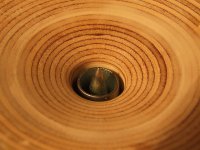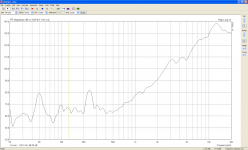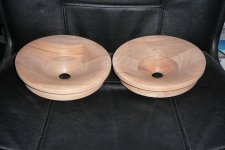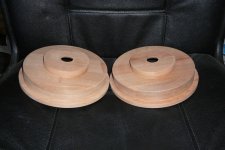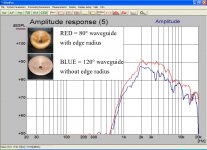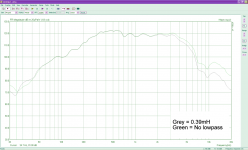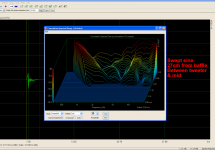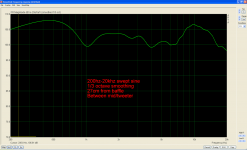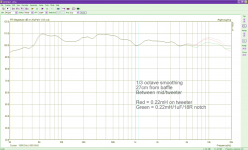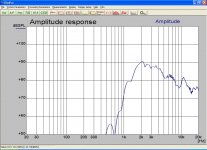My WGs are 8" in diameter. The test noise I hear now is slightly better to my ears, less resonant and nasal 🙂
I will take a measurement with a much larger capacitor so as to not have the really, really high and confusing high pass.
I will take a measurement with a much larger capacitor so as to not have the really, really high and confusing high pass.
Attachments
I think the reason your curve lacks some energy in the bottom, is because of the WG not loading the driver very well due to the large angle.
But I think it makes it easier to use with a high x-over point with the beta8, as it has a natural rolloff higher than on my 40 degrees WG.
But I think it makes it easier to use with a high x-over point with the beta8, as it has a natural rolloff higher than on my 40 degrees WG.
Interesting! I'm going to play around with the crossover a little more and then make changes to the other speaker. I could be some time.
Just to make sure I make a similar horn, can you also post the horn depth, I guess it's about 2,3 inches ?
It's really hard to measure with it in-situ but I'd say about 2.5"/6.2cm including the 10mm spacer section. More like 5.2cm without any spacers or adapters. It's a copy of the spreadsheet output.
I made a couple of 120° waveguide´s yesterday, 2" deep and 8" wide, so they should be pretty much the same as yours.
Now I have made a measurement compared with my small 80° waveguide.
This was a bit surprising, as I would have expected the lower freq to have less energy, but it is overall less effecient.
The more ripple in the graph is probably because of the missing edge radius, as this is designed to be mounted flat in a baffle.
Now I have made a measurement compared with my small 80° waveguide.
This was a bit surprising, as I would have expected the lower freq to have less energy, but it is overall less effecient.
The more ripple in the graph is probably because of the missing edge radius, as this is designed to be mounted flat in a baffle.
Attachments
I really think you should investigate your measurement setup, as it does not make sense your measurement show a rising response, when the driver has a falling response.
I also tried the beta8 together with the small 80° wg, in a quick, much to small, OB.
The beta8 was run fullrange and the driver/wg was crossed at about 5-6khz with a 3rd order filter. First a 2,5uF then a 3,3uF and between them a 0.140mH coil to ground.
The bass was handled by an old Altec 408 in a br cabinet, with a 2nd order filter with a 5mH coil and a 5,6mH coil in series and a 80uF cap in parallel with the driver
It sounded really good, and I have now decided to make an OB with the beta8 and the wg. What the bass driver should be I´m not quite sure of yet.
I also tried the beta8 together with the small 80° wg, in a quick, much to small, OB.
The beta8 was run fullrange and the driver/wg was crossed at about 5-6khz with a 3rd order filter. First a 2,5uF then a 3,3uF and between them a 0.140mH coil to ground.
The bass was handled by an old Altec 408 in a br cabinet, with a 2nd order filter with a 5mH coil and a 5,6mH coil in series and a 80uF cap in parallel with the driver
It sounded really good, and I have now decided to make an OB with the beta8 and the wg. What the bass driver should be I´m not quite sure of yet.
Last edited:
Wow, you're quite the expert turner, those look beautiful. Any idea why I get a rising response and you get a falling response? Do you think the drivers are different or is my measurement technique so bad it makes it completely wrong? I'd like to know what's going on here.
I see you posted whilst I was typing there. I agree something is not right, I'll try to look into taking more accurate measurements as I really don't trust them now... even though they're been "sufficient" to allow me to design the speakers.
The Beta 8A does sound quite decent as a mid driver. I'd say for bass your choice will depend on whether you take the high Q, low EQ route or a higher quality driver which you have to equalise more dramatically e.g. with a ~12mH coil in series. It also depends if you are willing to try H frame or U-frame or wish to keep things simple on one single baffle. If you can afford the width, the Eminence Alpha 15 has a superb reputation for making good open baffle bass.
The Beta 8A does sound quite decent as a mid driver. I'd say for bass your choice will depend on whether you take the high Q, low EQ route or a higher quality driver which you have to equalise more dramatically e.g. with a ~12mH coil in series. It also depends if you are willing to try H frame or U-frame or wish to keep things simple on one single baffle. If you can afford the width, the Eminence Alpha 15 has a superb reputation for making good open baffle bass.
(If I had the space I'd aim for 2 x 15" per side to avoid excessive cone excursions during normal listening, perhaps facing away from each other to cancel forces in one plane. 2 x 12" rocks the baffle hugely.)
Thx for the kind words about the new wg, it is a nice way to recycle an old kithen countertop.
I have some old drivers (Altec, Coral, JBL) I would like to use as they sound great, but I think their Qts is to low to use without massive amounts of eq. Maybe a H baffle could work.
Can you try to make a measurement of the Beta8 30cm from the baffle without the crosover in place, then I can do the same and compare the graphs.
Have you tried measuring a factory made loudspeaker, to see if that also shows the rising response.
I have some old drivers (Altec, Coral, JBL) I would like to use as they sound great, but I think their Qts is to low to use without massive amounts of eq. Maybe a H baffle could work.
Can you try to make a measurement of the Beta8 30cm from the baffle without the crosover in place, then I can do the same and compare the graphs.
Have you tried measuring a factory made loudspeaker, to see if that also shows the rising response.
I can readily post a curve of the Beta 8 from a fairly close distance as I have some to hand. I've not tried measuring any other speakers - that is a good idea. The only suitable ones around really would be my Tangent Monitor 6, which are my rear speakers.
The attached is the Beta 8 in isolation from about 20cm I think. The crossover was something like 250uF in series, and 0.4mH or no coil. There's also a booster circuit of about 12R in parallel with 8mH.
The attached is the Beta 8 in isolation from about 20cm I think. The crossover was something like 250uF in series, and 0.4mH or no coil. There's also a booster circuit of about 12R in parallel with 8mH.
Attachments
I've been measuring at different distances, and using a sine sweep or noise in the impulse response section of ARTA, as well as the steady (room-influenced?) pink noise measurements (labelled FR1 section). Whatever I do I get that rising tweeter response and, on the CSD, there is lots of resonance at about 15khz.
Simon,
Sorry to say (and it's probably too late), the angle of your WG seems too large -- and maybe it's why I felt it quite different from others I've seen.
I dug the WG thread a bit and found something related:
http://www.diyaudio.com/forums/multi-way/103872-geddes-waveguides-404.html#post2102864
And a couple of pages following that are about the angle of WG.
For your reference.
Sorry to say (and it's probably too late), the angle of your WG seems too large -- and maybe it's why I felt it quite different from others I've seen.
I dug the WG thread a bit and found something related:
http://www.diyaudio.com/forums/multi-way/103872-geddes-waveguides-404.html#post2102864
And a couple of pages following that are about the angle of WG.
For your reference.
So I've used 120deg overall angle and probably should've gone for 90 degrees or less. I take it this is the angle from the throat between a straight axial line from this point to the profile at either side? I wondered why my 'guides looked a little "shallow" and most were deeper. Perhaps they're not ideal, but we took so much effort to make them I need to make the most of them now. I will optimise the throat on the 2nd speaker and I will buy the reticulated HOM-absorber-foam and see what's what.
At least the overall sound from these speakers is GOOD.
The key things I've learned about open baffle reproduction is that it's not so easy to design a speaker with (crossover mainly) and the exceptional result only happens with bass. The midrange reproduction is, at best, on a par with a boxed speaker.
Maybe my next speaker will use a larger, deeper waveguide, a boxed midrange driver and even larger open baffle woofers.
At least the overall sound from these speakers is GOOD.
The key things I've learned about open baffle reproduction is that it's not so easy to design a speaker with (crossover mainly) and the exceptional result only happens with bass. The midrange reproduction is, at best, on a par with a boxed speaker.
Maybe my next speaker will use a larger, deeper waveguide, a boxed midrange driver and even larger open baffle woofers.
Ok, I thought it's about time I posted some more graphs lol.
Here's the current state of play as shown a short distance form the baffle of my right speaker, height more or less between the tweeter and midrange driver. I used a swept sinewave this time. I think it's too "quick" to allow time for low frequencies so it's cut off from the upper bass down.
As mentalistic as it probably sounds I'm going to insert a 0.22mH coil in series with my tweeter to do away with the tizzy higher frequencies. It will be interesting if not a good solution.. and I could boost the overall level to gain more in the presence region relative to the area of harmonics that is presently too loud.
If anyone would like to suggest better methods for measuring, I'm all ears 🙂
Here's the current state of play as shown a short distance form the baffle of my right speaker, height more or less between the tweeter and midrange driver. I used a swept sinewave this time. I think it's too "quick" to allow time for low frequencies so it's cut off from the upper bass down.
As mentalistic as it probably sounds I'm going to insert a 0.22mH coil in series with my tweeter to do away with the tizzy higher frequencies. It will be interesting if not a good solution.. and I could boost the overall level to gain more in the presence region relative to the area of harmonics that is presently too loud.
If anyone would like to suggest better methods for measuring, I'm all ears 🙂
Attachments
Last edited:
Simon, I have played around a bit with the Holm Impulse software, and you should try it out. It´s pretty easy to use, and I get the same results as with my DLSA measuring setup.
I have also tried a homebuilt mic to compare with the DLSA one, and they are identical in response, only the DLSA one being about 5db lower in output.
I tried to use my laptops first, but their soundcard would only go up to about 7khz, so I had to use the stationary one, which measured fine when doing the loopback test.
Try the Holm software with a loopback test, to see if you get the same rising response, or if your soundcard is flat.
I have added the graphs from the measurements, no smoothing only gating on the graphs.
This is of the driver/wg with and without crossover.
I have also tried a homebuilt mic to compare with the DLSA one, and they are identical in response, only the DLSA one being about 5db lower in output.
I tried to use my laptops first, but their soundcard would only go up to about 7khz, so I had to use the stationary one, which measured fine when doing the loopback test.
Try the Holm software with a loopback test, to see if you get the same rising response, or if your soundcard is flat.
I have added the graphs from the measurements, no smoothing only gating on the graphs.
This is of the driver/wg with and without crossover.
Attachments
Last edited:
Hi Kim,
You seem to be getting flatter or a more rising response now, is that due to the different waveguide?
I've downloaded the Holm software and installed it. I'll probably be able to have a look at it tomorrow.
I will also try to measure another speaker and at some point look into the loop test of the soundcard to rule that out of the equation.
You seem to be getting flatter or a more rising response now, is that due to the different waveguide?
I've downloaded the Holm software and installed it. I'll probably be able to have a look at it tomorrow.
I will also try to measure another speaker and at some point look into the loop test of the soundcard to rule that out of the equation.
- Status
- Not open for further replies.
- Home
- Loudspeakers
- Multi-Way
- 3 way open baffle with Eminence and Skytronic
